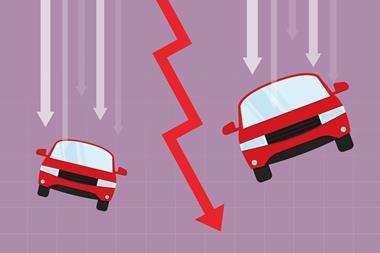Increased demands for profit at consolidated claimant law firms will come ’at the cost of the insurance industry and its clients,’ says partner
Rapid consolidation in the UK’s personal injury lawyer market could be set to deliver new challenges for the insurance sector.

As the insurance industry looks to fight its corner with the Ministry of Justice (MoJ) on its proposals to implement changes to the way injury awards are calculated, personal injury (PI) law firms are undergoing a round of consolidation.
The figures are stark. In 1999 Accident Lawyers 4U undertook a survey and found there were 2,000 claimant PI firms in the UK.
By 2021, data from the the OIC portal released by the MoJ revealed there were only 284 firms registered. These data also revealed that 83% of the claims submitted to the portal were submitted by just 12 of the largest firms.
This consolidation has led some to argue the market will soon be dominated by a handful of “mega” personal injury firms, which will have the capabilities, in terms of research and capacity, to rival those available to the major defence law firms.
With private equity companies looking to invest in the personal injury sector, there are also fears that the drive to deliver a return may well fuel efforts to create US-style class actions lawsuits with the aim of obtaining large group settlements.
Nicola Critchley, president of the Forum of Insurance Lawyers (Foil) and partner at law firm DWF, said: “We continue to see consolidation in the personal injury market and we have seen a significant drop in the number of high street firms offering personal injury services.
”The number of personal injury claims has reduced due to a combination of factors, including the pandemic and the whiplash reforms.
“Even the larger firms operating in this space has seen challenges and significant reduction in profits in recent years and it seems that economics of scale may be a key factor to longevity in this market, which is the subject of further reform with the fixed costs extension for cases up £100k being introduced in October 2022.”
A noticeable reduction
Liam McGuire, partner at Horwich Farrelly added: “In the past you could find several personal injury law firms in every town. It is no longer the case.”
He warned that the bigger the claims firms get, the more the more they would require claims volumes to maintain their income growth.
“If you are going to stay in the sector, particularly the high volume and small value claims, then you need to be serious,” he added.
“To be serious, [newly consolidated firms] need to make money and that has to be at the cost of the insurance industry and its clients.
”It is not a doomsday scenario but the industry needs to be aware of the move toward more consolidation and the challenges it may pose.”
Laurence Besemer, chief executive of the Foil added that the new larger firms would need to implement corporate rules that require a consistency of approach for the consolidation in the market to have any real effect.
“From low value slips and trips through to catastrophic injuries, fair settlements have always been achieved more efficiently when there has been good dialogue and understanding between the parties,” he explained.
“Whether this is more easily achieved as a result of the recent rapid consolidation of the claimant law firm market from a large number of small firms into a small number of large firms is not clear yet.”
Class action potential
The UK is already seeing a rise in the potential for more class action claims, with television advertising seeking claimants in order to build a large tort case.
McGuire says: “Ten years ago a lot of US law firms were taking an interest in the UK, but for several reasons it did not take off.
“Given the market is now more settled I wonder whether we may see a move to a more US style approach and a renewed interest from the US firms.”
Technology is also likely to have a role to play in the sector’s consolidation and the approach from claimant lawyers to the non-complex claims.
The use of artificial intelligence (AI) may allow claimant lawyer to simply use the AI system to operate the high volume, low value cases through the OIC portal.
AI would would reduce the costs of the case and also free up lawyers to focus on the more complex and higher value cases.
“As technology and AI becomes more accessible it could be used for the volume work,” said McGuire.
“The AI could be not only programmed to move the non-complex cases through the portal but be tasked to identify those cases which could be potentially more valuable. The use of AI would deliver not only cost efficiencies but also consistency of approach.
“The bigger firms will use AI to run cases through the portal from start to finish.
“It could use past data to identify the cases where a whiplash claim has progressed to a chronic claim pain and highlight new cases which mirror that data as claims that require greater consideration.
“In the past you would need a paralegal to go thought the background and make a decision to whether the claim should be put on a certain track.”
Potential upsides?
The move to larger but fewer personal injury firms may have some upsides, despite the threat to the insurance industry.
Besemer explained: “On the one hand, the same claimant law firm is now likely to be settling claims with the same insurer or defendant lawyer more often and this regular engagement should, in theory, create better relationships and lead to more effective communication.
”On the other hand, with multiple offices and many handling solicitors, it’s unlikely that the same individual solicitor will be regularly dealing with the same insurer or defendant lawyer.
”Unless the very large claimant law firms adopt corporate policies – statements of handling practice that are enforced across all offices – claims handling behaviours are unlikely to be any more consistent, and thereby productive, than they were when the claimant community was a disparate number of small firms.”
McGuire said if the bigger law firms looked to implement a strategy across its entire company then it may well aid insurers and their lawyers.
He said: “If the claimant lawyers adopt a specific approach to cases, it will enable the defendant lawyers to understand the approach they will take and with it adapt their defence to counter the claimant strategy.”Not subscribed? Become a subscriber and access our premium content












































No comments yet